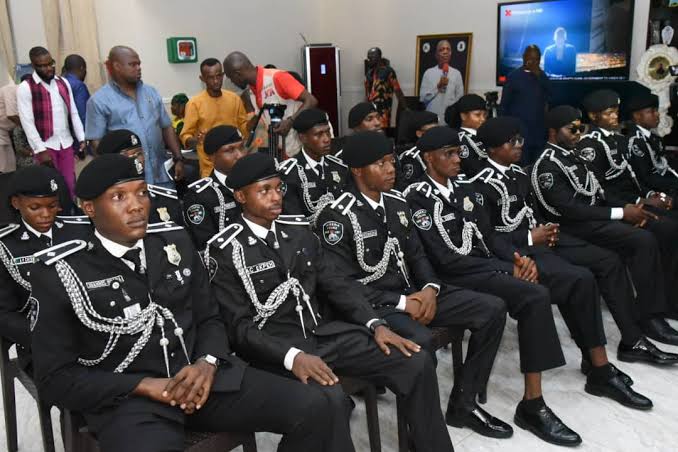The Nigeria Police Force (NPF) is the principal law enforcement agency in the country. It plays a crucial role in maintaining peace and order, enforcing laws, and protecting the lives and properties of Nigerian citizens. If you're curious about the official ranks in the Nigerian Police Force and the symbols that represent them, this guide provides a clear breakdown of everything you need to know.

Commissioned Officers Ranks and Symbols
These are the top ranks in the Nigerian Police and are usually appointed through promotion, direct entry, or presidential approval.
| Rank | Symbol/Insignia | Description |
|---|---|---|
| Inspector General of Police (IGP) | Crossed tipstaves in a laurel wreath with Nigeria’s Coat of Arms | The highest-ranking officer in the NPF. Appointed by the President. |
| Deputy Inspector General (DIG) | Crossed tipstaves in a laurel wreath | Reports directly to the IGP and heads a department. |
| Assistant Inspector General (AIG) | Three stars above a crossed tipstave and baton | Oversees a police zone. |
| Commissioner of Police (CP) | Nigeria Coat of Arms | Heads a state police command. |
| Deputy Commissioner of Police (DCP) | Three stars | Deputy to the CP in a state command. |
| Assistant Commissioner of Police (ACP) | Two stars | Assists in managing police divisions. |
| Chief Superintendent of Police (CSP) | One star with crossed tipstaves | Heads a major unit or department. |
| Superintendent of Police (SP) | One star | Supervises larger police stations. |
| Deputy Superintendent of Police (DSP) | Two shoulder bars | Second-in-command at a division. |
| Assistant Superintendent of Police (ASP I & II) | Single shoulder bar | Entry-level for commissioned officers. |
Non-Commissioned Officers (Junior Ranks) and Their Symbols
These officers form the operational backbone of the force, performing day-to-day duties in maintaining law and order.
| Rank | Symbol/Insignia | Description |
|---|---|---|
| Inspector of Police | Two bars | Senior rank among non-commissioned officers. |
| Sergeant Major | Warrant badge | Usually in charge of discipline at divisions. |
| Sergeant | Three chevrons pointing down | Carries out patrol and enforcement duties. |
| Corporal | Two chevrons | Supports Sergeants in policing duties. |
| Constable | One chevron | Entry-level rank for junior officers. |
| Police Recruit | No insignia | Undergoing training at the police academy. |
Key Notes About Police Ranks in Nigeria
-
Recruitment into NPF starts from the Constable level or ASP through the Police Academy or direct entry (for degree holders).
-
Promotions are based on years of service, performance, and availability of positions.
-
Symbols and insignia are worn on uniform shoulders, collars, or caps, depending on the rank.
Importance of the Rank Structure
-
Discipline: Maintains order and accountability.
-
Chain of Command: Establishes clear lines of authority.
-
Career Progression: Provides a roadmap for promotions and responsibilities.
-
Specialization: Officers assume roles based on rank and experience.
How Promotions Work in the Nigerian Police
Promotions in the Nigerian Police Force are merit-based, taking into account:
-
Years of service
-
Performance and discipline records
-
Exams and interviews
-
Recommendations by superior officers
The Police Service Commission (PSC) is responsible for the promotion of officers from ASP to DIG, while the President appoints the IGP.
FAQs: Nigerian Police Ranks and Symbols
Q1: What is the highest rank in the Nigerian Police Force?
A: The highest rank is the Inspector General of Police (IGP).
Q2: What is the lowest rank in the Nigerian Police Force?
A: The lowest rank is Police Constable, while Police Recruit refers to trainees undergoing police training.
Q3: How many stars does an Assistant Superintendent of Police have?
A: ASP I has two stars, while ASP II has one star.
Q4: What is the difference between Commissioned and Non-Commissioned officers?
A: Commissioned officers (ASP and above) hold leadership and administrative roles. Non-commissioned officers (Inspector and below) carry out field and operational duties.
Q5: How long does it take to rise in rank in the Nigerian Police?
A: It varies based on qualifications, performance, and vacancy. Generally, an officer may need 3–7 years before moving up, depending on rank.
Q6: Are symbols and insignias worn on all uniforms?
A: Yes. Rank symbols are prominently displayed on uniforms, caps, and shoulder badges.
Q7: What rank does a university graduate start with in the Nigerian Police?
A: A university graduate begins as Assistant Superintendent of Police II (ASP II) after completing training at the Police Academy.
Conclusion
Understanding the Nigerian Police ranks and symbols is essential for recognizing the command structure and appreciating the responsibilities of law enforcement officers. From the IGP down to the constable, every rank plays a vital role in ensuring safety and security in Nigeria.
As the NPF continues to reform and modernize, the rank structure remains a pillar of professionalism, discipline, and effective service delivery.











